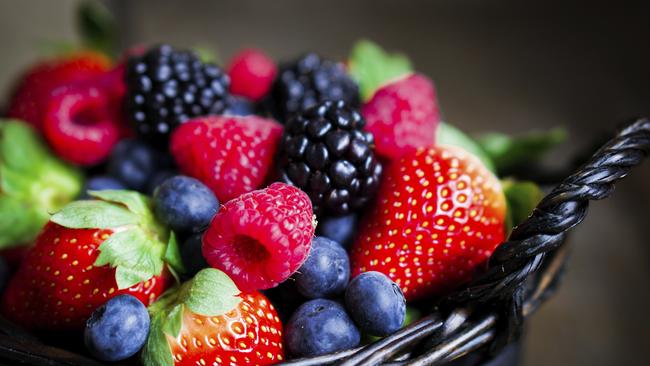Some berry good gardening ideas for summer
FRESH berries are a delicious part of summer, and some of them are easy to grow at home where you can pick them at their best.

FRESH berries are a delicious part of summer, and some of them are easy to grow at home where you can pick them at their ripest and freshest.
Over several years, I’ve had the most success with the least effort from growing blueberries in large pots. They’re attractive shrubs that bear pretty flowers and produce a surprisingly large harvest in a small space.
What I really like is that blueberries ripen over an extended period of time, rather than all at once, so I can go out most days to pick a handful from each plant, and this continues for many weeks. I also love that they never seem to suffer from pests or diseases, unlike so many fruits. However, netting them is essential to protect the crop from sharp-eyed birds.
I use a metal-framed cage covered with bird netting, available from hardware and garden stores, that is easy to erect and collapse as needed. There are evergreen and deciduous types of blueberries, with different chilling requirements, so choose a variety that suits your area.
As blueberries prefer acidic soil, a potting mix for camellias and azaleas is ideal, then mulch the top of the pot with pine needles. The dropped needles from your fresh Christmas tree, once it’s finished, will be perfect.
Strawberries are also easy to grow, and a favourite in the garden for children. They grow in most parts of Australia, except the tropics, and bear fruit at various times according to the region. Grow them from certified virus-free runners on raised rows or in large pots or troughs. Plants last up to three years before being replaced. They’re hungry plants that benefit from well-prepared soil and additional, regular feeding, and need consistent watering for juicy berries.
Tuck straw under the developing fruit clusters to keep them clean and help protect from snails — that’s why they’re called strawberries.
Raspberries are even more delicious but significantly harder to grow. They’re part of a broad group of brambles that includes blackberries, loganberries, youngberries, silvanberries, boysenberries and others. They usually have long, thorny canes, but thornless varieties are available. These are plants that thrive in cooler climates. In subtropical areas, look for the keriberry, blackberries and ‘Heritage’ raspberry, which have lower chilling requirements. Wild blackberries are serious weeds but growing selected commercial varieties is permitted in many areas. Grow brambles in trellised rows with ample space as they are all vigorous growers, and be prepared to tackle the tasks of pruning and training with gusto.
As it’s Christmas you might be thinking cranberries but don’t be tempted to try growing them here. They need highly specialised conditions that include a peat-bottomed bog and icy climate. The shiny, red berries, which are sour when fresh, grow on trailing evergreen vines and are native to North America. For a native alternative, make your turkey-accompanying jelly from lillypillies such as riberry (Syzygium luehmannii).
All berry fruits need a position with plenty of sun and protection from wind.
Investigate the most favourable varieties for your particular area before buying plants and, of course, use only organic treatments for any problems.
TWIG
Q. Having admired potted olive trees in France, I’d like to try one. What type of olive would you suggest?
Chrissie Peel, Lake Macquarie, NSW
A. Olive trees grow happily in your subtropical climate but don’t fruit well without cross-pollination and drier summers. For potted specimens, this shouldn’t be a problem as their silver foliage is the main attraction. All varieties do well in large pots in full sun; the key to maintaining dense and shapely plants is frequent tip pruning from the beginning.
Q. What can we plant in shallow soil between two driveways, which stays narrow and reaches 2.5m? Would bamboo work?
Lesley Richmond, Sydney Northern Beaches
A. Clumping bamboos make fast, upright hedges but if too hot and dry they drop leaves. Add organic matter and water-storing crystals to your sandy soil, and install irrigation. Popular Slender Weavers bamboo reaches 7m; smaller choices are ‘Stripestem Fernleaf’, ‘Goldstripe’ or ‘Murray Island’. Alternatively, use star jasmine on a trellis.
Q. Is there a natural way to remove flyspeck scale from my bromeliads? Rogor and Confidor are nearly killing me and are ineffective.
Sharon Markwell, Caboolture, Queensland
A. Rogor is a toxic organophosphate, now withdrawn for home use. Dispose of safely through your council’s hazardous waste program. Confidor is safer but harmful to bees. Note the shells of hard scales persist after the pests are dead. Scrub them off with an old toothbrush. Horticultural soaps such as Natrasoap can help.
Q. How does one propagate Petrea?
Joan McColl, Peregian Springs, Queensland
A. Petrea volubilis or Queen’s wreath is a twining, woody climber with a long display of unusual violet flowers that hang in bunches like wisteria. Sandpaper vine is another name because of its rough leaves. Propagate from seeds, roughened and soaked in water for a day, or hardwood cuttings, or semi-hardwood cuttings with bottom heat. Air layering is also possible with this plant.
Send your questions to: helenyoungtwig@gmail.com or Helen Young, PO Box 3098, Willoughby North, NSW 2068. Website: helenyoung.com.au. The best question for December wins a multicoloured, luxury hammock, handwoven by fair-trade artisans in Latin America, worth $189 from thetoucanshop.com.

